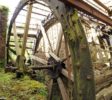
Ennish Flax Mill is 1 of just 3 working Scutch Mills in Northern Ireland.
The Industrial buildings have been listed as Grade B1.
Ennish Flax Mill is a remarkable Industrial Heritage site located in the townland of Ennish, Co. Tyrone, Northern Ireland. Thanks to the work of owner Harold Bennett, many hours have been spent maintaining and restoring much of the equipment left over since the Mill closed in 1950.
The site began as a Corn Mill with a Flax Mill being added in the late 1700s.
The earliest image of the site known gives a clear indication that there were in fact 2 mills in operation in 1780, side by side.
The Mill(s) were powered by a mill race, which must have achieved a considerable power to drive two mills!
In 1782 the Mills were leased by John Burges, Armagh for the sum of £38 per year for the lives of himself, son John Henry and daughters Mary & Martha. The lease stated that the leasee was required to give preference to grinding corn or processing flax from the neighbouring four townlands.
The Burges family would remain in control of the Mills for another 135 years and settle at nearby Parkanaur Manor, Castlecaulfield. There is a plaque on the corn kiln which reads ‘Rebuilt by J. Y. Burgels 1850’. This was the grandson of John Burges.
In 1917 William Samuel Bennett purchased the mill from Colonel Ynyr Henry Burges for £255.00. At that time the flax industry was booming so he converted the corn mill into a Flax Mill.
Records show that flax was first scutched in October 1917.
Farmers who brought their flax to be scutched came from areas such as Crilly, Minterburn, Rehaghey, Brantry, Newmills, Clonavaddy and Castlecaulfield.
In 1944, an engine was installed to drive the mill.
Good flax could be scutched into long, strong fibres which would eventually be woven into fine linen cloth. Upon completion of scutching the flax was brought to Union Street, Cookstown to be inspected. If it passed the Grading Inspector it was sent to a Linen Mill in Belfast where it was woven into linen fabrics.
After WWII the flax industry suffered an unexpected decline because man-made fibres arrived on the scene, so the mill closed in 1950.
In 2013 it was decided that a dedicated group should be setup to carry out extensive repairs to the buildings and other equipment on the site and to better market the Mill as a Community Heritage resource.
In the last few years a number of events involving the local community have been hosted at the Mill showcasing its working equipment and the potential for it to enhance knowledge of the golden age of the Linen Industry in local history.
Check out their website – HERE!

Ennish Flax Mill is 1 of just 3 working Scutch Mills in Northern Ireland.
The Industrial buildings have been listed as Grade B1.
Ennish Flax Mill is a remarkable Industrial Heritage site located in the townland of Ennish, Co. Tyrone, Northern Ireland. Thanks to the work of owner Harold Bennett, many hours have been spent maintaining and restoring much of the equipment left over since the Mill closed in 1950.
The site began as a Corn Mill with a Flax Mill being added in the late 1700s.
The earliest image of the site known gives a clear indication that there were in fact 2 mills in operation in 1780, side by side.
The Mill(s) were powered by a mill race, which must have achieved a considerable power to drive two mills!
In 1782 the Mills were leased by John Burges, Armagh for the sum of £38 per year for the lives of himself, son John Henry and daughters Mary & Martha. The lease stated that the leasee was required to give preference to grinding corn or processing flax from the neighbouring four townlands.
The Burges family would remain in control of the Mills for another 135 years and settle at nearby Parkanaur Manor, Castlecaulfield. There is a plaque on the corn kiln which reads ‘Rebuilt by J. Y. Burgels 1850’. This was the grandson of John Burges.
In 1917 William Samuel Bennett purchased the mill from Colonel Ynyr Henry Burges for £255.00. At that time the flax industry was booming so he converted the corn mill into a Flax Mill.
Records show that flax was first scutched in October 1917.
Farmers who brought their flax to be scutched came from areas such as Crilly, Minterburn, Rehaghey, Brantry, Newmills, Clonavaddy and Castlecaulfield.
In 1944, an engine was installed to drive the mill.
Good flax could be scutched into long, strong fibres which would eventually be woven into fine linen cloth. Upon completion of scutching the flax was brought to Union Street, Cookstown to be inspected. If it passed the Grading Inspector it was sent to a Linen Mill in Belfast where it was woven into linen fabrics.
After WWII the flax industry suffered an unexpected decline because man-made fibres arrived on the scene, so the mill closed in 1950.
In 2013 it was decided that a dedicated group should be setup to carry out extensive repairs to the buildings and other equipment on the site and to better market the Mill as a Community Heritage resource.
In the last few years a number of events involving the local community have been hosted at the Mill showcasing its working equipment and the potential for it to enhance knowledge of the golden age of the Linen Industry in local history.
Check out their website – HERE!

